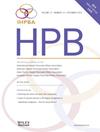导航新领域:美国肝移植的现场机器灌注。
IF 2.7
3区 医学
Q2 GASTROENTEROLOGY & HEPATOLOGY
引用次数: 0
摘要
背景:肝移植(LT)需求的增加需要对边缘供体的最佳利用,包括心源性死亡(DCD)后供体、年龄较大和脂肪变性供体。现场机器灌注(OMP)可能使以前未利用的器官可用。目前缺乏使用美国国家数据库对肝移植中OMP安全性的全面研究。方法:本研究旨在利用UNOS数据库(2016-2023)评估OMP在LT中的使用情况及其影响。通过供体器官丢弃指数(DSRI)评估边际供体质量对受者结局的影响。结果:在50,458例LT病例中,1263例(2.5%)使用了OMP。自2022年以来,OMP的使用量激增,在2023年初(1 - 6月)超过了10.0%。在DBD中,OMP肝脏的中位DSRI高于非OMP肝脏(2.33vs1.73, P 13), OMP使用与风险比(HR)显著低于未使用相关。大脂肪变性≥30%的OMP患者无移植物失败。OMP没有显示HR随供体年龄的线性增加。结论:OMP商业化后在LT中的使用显著增加,尽管DSRI较高,但其结果与非OMP相当。它有望优化边际捐助者的使用,潜在地扩大捐助者池。本文章由计算机程序翻译,如有差异,请以英文原文为准。
Navigating new frontiers: onsite machine perfusion in US liver transplantation
Background
The increasing demand for liver transplantation (LT) necessitates optimal utilization of marginal donors including donation after cardiac death (DCD), older, and steatotic donors. Onsite machine perfusion (OMP) might make previously non-utilized organs useable. Comprehensive studies on OMP’s safety in LT, using the US national database, are lacking.
Methods
This study aimed to assess OMP usage and implications in LT, using the UNOS database (2016–2023). The impact on recipient outcomes of marginal donor quality as assessed by the donor organ discard index (DSRI) was examined.
Results
Of 50,458 LT cases identified, 1263 (2.5 %) utilized OMP. OMP usage had surged since 2022, exceeding a 10.0 % proportion in early 2023 (Jan–June). In DBD, OMP livers had higher median DSRI than non-OMP livers (2.33vs1.73, P < 0.01) but had comparable graft survival (GS). DCD livers had better 90-day/1-year GS when OMP was used despite having a higher DSRI (24.3vs18.6, P < 0.01). For DCD donors with high DSRI (>13), OMP utilization correlated with a significantly lower hazard ratio (HR) than non-utilization. OMP cases with macrosteatosis≥30 % reported no graft failures. OMP did not exhibit a linear increase in HR with donor age.
Conclusion
OMP’s usage in LT significantly increased after its commercialization, offering comparable outcomes with non-OMP despite higher DSRI. It holds promise in optimizing marginal donor use, potentially expanding the donor pool.
求助全文
通过发布文献求助,成功后即可免费获取论文全文。
去求助
来源期刊

Hpb
GASTROENTEROLOGY & HEPATOLOGY-SURGERY
CiteScore
5.60
自引率
3.40%
发文量
244
审稿时长
57 days
期刊介绍:
HPB is an international forum for clinical, scientific and educational communication.
Twelve issues a year bring the reader leading articles, expert reviews, original articles, images, editorials, and reader correspondence encompassing all aspects of benign and malignant hepatobiliary disease and its management. HPB features relevant aspects of clinical and translational research and practice.
Specific areas of interest include HPB diseases encountered globally by clinical practitioners in this specialist field of gastrointestinal surgery. The journal addresses the challenges faced in the management of cancer involving the liver, biliary system and pancreas. While surgical oncology represents a large part of HPB practice, submission of manuscripts relating to liver and pancreas transplantation, the treatment of benign conditions such as acute and chronic pancreatitis, and those relating to hepatobiliary infection and inflammation are also welcomed. There will be a focus on developing a multidisciplinary approach to diagnosis and treatment with endoscopic and laparoscopic approaches, radiological interventions and surgical techniques being strongly represented. HPB welcomes submission of manuscripts in all these areas and in scientific focused research that has clear clinical relevance to HPB surgical practice.
HPB aims to help its readers - surgeons, physicians, radiologists and basic scientists - to develop their knowledge and practice. HPB will be of interest to specialists involved in the management of hepatobiliary and pancreatic disease however will also inform those working in related fields.
Abstracted and Indexed in:
MEDLINE®
EMBASE
PubMed
Science Citation Index Expanded
Academic Search (EBSCO)
HPB is owned by the International Hepato-Pancreato-Biliary Association (IHPBA) and is also the official Journal of the American Hepato-Pancreato-Biliary Association (AHPBA), the Asian-Pacific Hepato Pancreatic Biliary Association (A-PHPBA) and the European-African Hepato-Pancreatic Biliary Association (E-AHPBA).
 求助内容:
求助内容: 应助结果提醒方式:
应助结果提醒方式:


